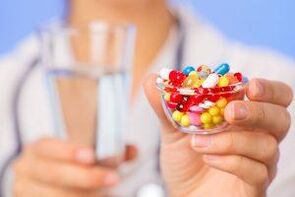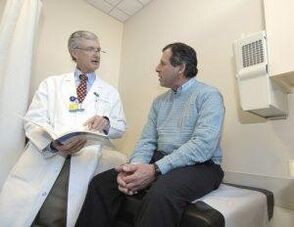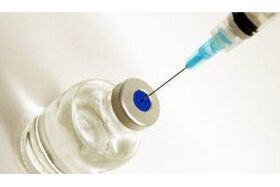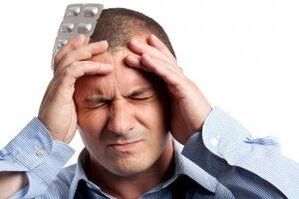
Prostatitis is a prostate disease that can be very painful, but with the right comprehensive approach, the disease will subside. Let's consider the most famous drug treatments in more detail -antibiotic use- Which antibiotics are best for men with prostatitis?
antibiotic

Treatment of prostatitis with medication is usually limited to controlling its symptoms. Painkillers can relieve pain. Using antibiotics to treat prostatitis in menFor patients with acute or chronic infectionsprostate.
E. coli and other gram-negative bacteria cause the most acute prostate infections.Symptoms includeGroin pain, difficulty urinating, pain during ejaculation, inability to urinate, and fever, general malaise.
Treatment of prostatitis in men is always with antibiotics. Chronic infectious prostatitis may require long-term medication, severe infections may require hospitalization, and medication will be administered parenterally.
In this article, we will consider how to treat prostatitis in men with antibiotics.
advantages and disadvantages
Antibiotics are always recommended if an infection develops or the disease recurs within a year. They are suitable for effective treatment of:
- acute infectious prostatitis;
- Chronic infectious prostatitis.
The benefits of the drug include:
- strongbactericidal properties;
- Antibacterial propertiesprevent bacterial growth;
- high efficiency– covers a wide range of infections;
- easy to use. Most medicines are taken by mouth or by injection;
- fewer side effects;
- economyDrugs are widely available and inexpensive.
Disadvantages includesystemic side effects, depending on the antibiotic chosen, the most common include:
- diarrhea.Usually, sugar in the gut increases during treatment, leading to an imbalance in the gut flora;
- fungal infectionoral cavity, reproductive organs;
- formkidney stones;
- coagulation disorderblood (when taking certain cephalosporins);
- Sensitivity(when taking tetracycline);
- blood disease("thick" blood syndrome);
- deaf(rare).
Common side effects include:
- possibilityallergic reaction;
- resistance of some bacteria. This can happen if the patient takes an incomplete dose.
Types of antibiotics

In most cases, the patient is prescribed4 week course, but if a urologist suspects chronic prostatitis and symptoms (and pain) do not go away after 4 weeks of treatment, he may recommend an extended intake.
Courses as long as three months are sometimes used.
Antibiotics for prostatitis in menPrescribed by the attending physiciandepending on:
- the pathogen causing the infection;
- form of disease (acute/chronic);
- severity of symptoms;
- the general health of the patient;
- age.
and based on this resultanalyze, how:
- blood test - extended profile;
- General urinalysis;
- urethral PCR (smear);
- tank. urine culture;
- Prostate secretion analysis.
Types of antibioticsFor prostate treatment:
- macrolides;
- penicillin;
- tetracyclines;
- Fluoroquinolones;
- cephalosporin.
Which antibiotic is better and more effectiveSuffering from prostatitis? Consider the names of prostatitis antibiotics:
| work | the effectiveness of the drug | action taken | Usage advice (more details in description) |
|---|---|---|---|
| Macrolides | Effective against urinary tract diseases (prostatitis, urethritis, cervicitis, epididymitis) | Slows down the active growth and reproduction of bacteria, has antiseptic and antibacterial effects, and has bactericidal effects | 1-2 g 2-3 rpm/day Release form: 10 tablets. 500 mg |
| Macrolide Semisynthetic Drug Erythromycin Derivatives | Effective for the treatment of chronic infectious prostatitis | Broad-spectrum antibiotics. It has a broad antibacterial effect and many prostatitis-causing bacteria are drug-sensitive (Streptococcus, Klebsiella, Escherichia coli, Staphylococcus aureus) | 0. 15 g 2 r/day before meals, with plenty of liquid Provides 10 capsules. 0. 15, 0. 3, 0. 1 and 0. 05 grams each |
| Tetracycline Derivatives | Effective treatment of acute/chronic prostatitis, chlamydia, gonorrhea, syphilis and other infections | Has bacteriostatic and anti-inflammatory effects | 200 mg once with plenty of fluids with meals, then 100 mg once daily Produced in 10 capsules. 100 mg |
| Semi-synthetic cephalosporins | Antibiotics for the treatment of acute bacterial prostatitis in men. It was shot against the background of a severe bacterial infection | It has antibacterial and bactericidal effects. Active against many prostatitis-causing microorganisms (Streptococcus, Staphylococcus aureus) | 1 gram intramuscularly or intravenously every 8-12 hours Release form: 0. 5, 1 or 2 g injection ampoules |
| Cephalosporin preparation (sodium salt form) | For severe bacterial infections (prostatitis, epididymitis) | Antibacterial and bactericidal | IM or IV, 1-2 grams every 12 hours Available in 0. 5, 1 or 2 gram bottles |
| Semisynthetic broad-spectrum antibiotics of penicillins and clavulanic acid | This antibiotic is used to treat prostatitis, as well as gynecological and respiratory infections. | Bactericidal against Gram-positive and Gram-negative aerobic/anaerobic bacteria | 1 tablet 250 mg every 8 hours (+125 mg) Produces 15 tablets 250+125 mg in tablet form |
| Semisynthetic drugs of the penicillin group | For the treatment of genitourinary infections (urethritis, prostatitis, pyelonephritis) | Antibacterial and bactericidal | Antibiotic for prostatitis, intramuscularly or intravenously, 500 mg 3 r/day or in tablet form, 500 mg every 8 hours Manufactured in ampoules for 500 mg injection or 20 tablets. 500 mg |
| lomefloxacin hydrochloride | For prostatitis, chlamydia, pyelonephritis, urethritis | It has antibacterial and bactericidal effects and is active against gram-negative microorganisms that cause prostatitis | 400 mg in tablet 1 r/day Produced in 10 capsules. 400 mg |
| Fluorinated carboxyquinolone, a synthetic chemotherapeutic agent | antibiotics for prostate inflammation | Active against Streptococcus, Staphylococcus, Chlamydia and other bacteria | Oral 250 mg tablet with plenty of fluids after or before meals 5 tablets are produced in tablet form. 250 mg |
| Fluoroquinolone antibiotics | Urinary tract, pelvic organ, reproductive organ infections | It has antibacterial and bactericidal effects, and is active against Streptococcus, Staphylococcus, Chlamydia, Enterococcus, Mycoplasma and other bacteria | 1 tablet 200-800 mg/day before meals Produced in tablets of 10. 200 mg |
| Drugs from the tetracycline group | For respiratory infections, chlamydia, prostatitis, syphilis | Antibacterial and bacteriostatic effect | 1 tablet 250-500 mg 4 r/day Produced in tablets of 10. 250 mg |
Only your attending physician can decide which antibiotic complex is right for you.
If antibiotics don't help with prostatitis, then you can turn to helpfolk remediesAnd try to treat prostatitis without antibiotics. Here are some of them: Pumpkin Seeds and Honey, Propolis, Propolis Candles, Dead Bees, Soda and Hydrogen Peroxide, and Monastery Tea, Ivan Tea and Onions. You can also buy Chinese prostatitis patches.
injection

If the body does not respond to oral treatment, specialists may prescribe parenteral administration (Intravenous/Intramuscularusually on the buttocks).
This method is also used to treat chronic/acute infectious prostatitis. It should only be considered after all other options have been tried, including oral antibiotic therapy for prostatitis, corticosteroid therapy, and traditional medicine.
Parenteral administration is used if the patient has taken several courses of antibiotics over several months that have not been effective.
This response is due to the fact that infectious prostatitis is often caused by local inflammatory processes in the context of autoimmune diseases, and oral medications have not had the desired effect.
What is the injection for prostatitis?
Antibiotics are usually given intravenously (and intramuscularly).The third generation cephalosporin group.The injection is strictly performed in the hospital. Relief usually occurs after 5 injections.
Contraindications

Contraindications usually depend on the specific drug, but the most common include:
- Gastrointestinal disease(especially when taking macrolides);
- allergic reaction (measles);
- damage to the kidneys and liver(usually in the context of taking penicillins, cephalosporins, macrolides);
- childhood(with caution until age 18);
- diabetes.
how to take
Tablets should be taken with 1. 5-2 glasses of water, and the drug should be taken with meals (unless otherwise stated in the instructions) so as not to irritate the stomach. drinking alcohol after antibiotic treatmentMedications to restore gut flora.
attention!Completely avoid alcohol during treatment.
replace
Infectious prostatitis can be successfully treated with antibiotics, but if there are contraindications to admission, or if you have individual intolerance, are allergic to certain components of the drug, or antibiotics do not help prostatitis, the so-called,natural antibioticssuffer from prostatitis. They are generally less effective at fighting infectious forms of the disease. So what can replace antibiotics for prostatitis?
most commonly usedEchinacea, in its composition there is a special substance - echinacea, whose properties are completely different from conventional antibiotics.
Infusions, herbal teas, and decoctions are all plant-based and allow you to relieve prostate inflammation without antibiotics.
have a similar effectpoplar bark, which are called "natural" antibiotics.
Used to treat bacterial forms of the diseasealso appointed:
- Alpha-blockers;
- non-steroidal anti-inflammatory drugs;
- corticosteroids;
- 5-alpha inhibitors (slows prostate growth);
- laxative.
With prompt medical care and a comprehensive approach to treatment, bacterial prostatitis can be completely cured with a course of antibiotics.



























